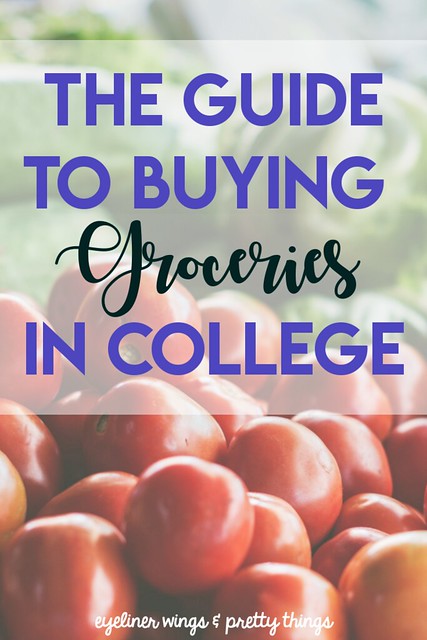One thing I unexpectedly did very often was buy groceries in college. Most of the places I lived had kitchens which also meant I feld obligated to actually cook and, well, buy groceries.
In college, I was constantly busy and overwhelmed. I sometimes went to the grocery store with no list and left with hardly any real food. Other times I bought too much and ended up tossing expired fruits and snacks. But, by the end of the four years I established a pretty solid grocery shopping routine and even managed to do so on a pretty solid budget.
1. Pick a set time to go every week or two.
Figure out how often you actually need to visit the grocery store. Pick a time that consistently works for you. Go every Monday at 3:30 or every Sunday at noon. Pick a time, schedule it in like it’s a class and stick to it. This will help you avoid running out of groceries.
2. Consider grocery delivery service.
My friend and I didn’t have cars (and I still don’t) sophomore year so we used Peapod delivery service. We split the cost and ordered groceries every two weeks so we were able to buy meals. Peapod was pretty handy but there is a huge waiting window where you need to be home to pick up the groceries. Again, picking a set time for when you can be home and put your groceries away each week is a smart idea.
3. Buy in bulk when there’s a good sale.
There were some items I only bought once a month or even once a semester because I bought them in bulk. Do this with ingredients you cook with often or food you love that won’t go bad quickly or than you can freeze. I liked to do this with cans of chickpeas (my favorite) and also broth. I used both when I cooked often and it was nice to have them on hand.
4. Keep emergency staples at home.
Even if you forget grocery shopping, you’ll have these in your fridge and freezer. Some of the staples I always had in my kitchen were:
Two frozen slices of “Emergency Bread” (bread goes bad faster than I can eat it!)
Peanut butter
A lean cuisine
Frozen broccoli
Pasta
A can of sauce
Cans of soup
A box of mac and cheese
Quinoa
Chicken/Vegetable Broth
Eggs
Frozen turkey sausage
Generally, these can all be used to make a simple meal. Breakfast for dinner and frozen meals were a lifesaver on long days when I didn’t have time to buy groceries or was just too lazy to cook.
5. Keep a running list on your phone.
I liked using my all-time, much-mentioned app, the Reminders app for this one. I mad a tab for groceries and kept track whenever I ran out of something or it came to mind. If it was something I needed, I starred it. This was stuff like coffee creamer or milk. If it was something I wanted but didn’t need, I didn’t star it and only bought it if it was on sale or had a good deal.
This was a great way to save money and prioritize my groceries. I also usually made substitutions to my wants with whatever was on sale but similar, like buying broccoli instead of asparagus because it was cheaper that week.
6. Split with friends.
Not everything needs to be shared or should be shared, but some items you know you won’t finish can be great to share. My friend often split rotisserie chickens and I usually shared milk with my friends because I’d never drink any on my own and I only used it for a few recipes. Some items that aren’t used often are great to split the costs of or to alternate who buys it each week.
Related: The Guide to Being Money Smart in College
7. Write down what’s going bad and what needs to be used.
Sticky notes were a lifesaver. As soon as I unpacked my groceries, I wrote down all of my perishables like produce, veggies and meat and stuck it on the fridge. This way, I was able to eat things before they went bad. With so many housemates, my stuff got buried in the fridge and I so easily forget about what I bought, so this was great. I also, no surprise, set reminders to eat certain foods by the end of the week.
8. Do your best to vaguely meal plan.
No matter how much I tried and how much I tried to will it into existence via Pinterest, I was so busy (and lazy) in college that meal planning just didn’t work longer than two days. Instead, I made my own version of meal planning which was cooking dinner at least three times a week, making big lunches on days when I didn’t have afternoon classes and collaborating with my housemates to have some sort of accountability via the concept of “family dinners.” Cook twice a week. Prep meals in advance. Cook one-pot meals. Make dinner with friends. Figure out which planning method actually works for you.
Related: Things I Wish I’d Known Before Moving Into College
9. Pick one of each “type” of snack each time.
I don’t believe you should totally deprive yourself. Every other time I went grocery shopping (or sometimes every time) I bought a sweet snack (usually whatever cookies I liked were on sale) and a salty snack (typically chips or Goldfish crackers). Sometimes I bought more. But, I tried to only buy snacks when they were on sale because of how not necessary they were.








Hi Paige, these are great tips! I’ve heard good things about grocery delivery services in my town, so I’m going to try that next semester. I also want to start vaguely meal planning, too!
-Aly (welcometoalysworld.com)
It’s great especially if you don’t have a car! Thanks for reading 🙂